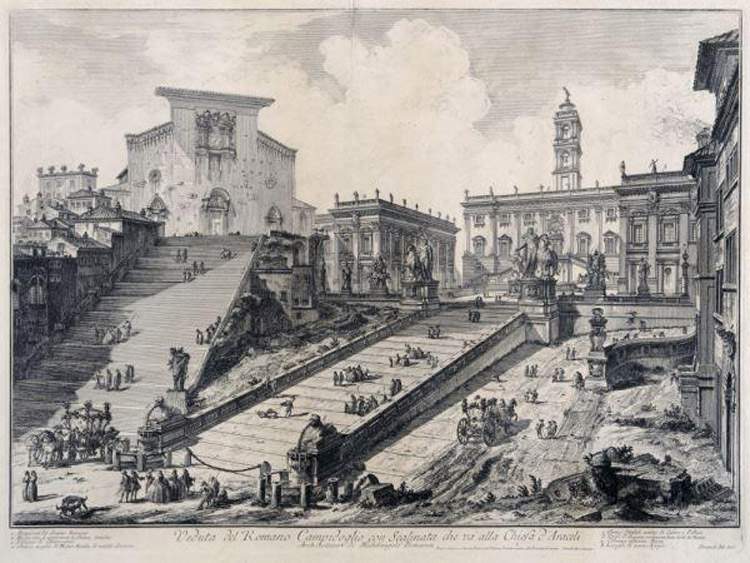The exhibition Piranesi opened today, and will run until October 15, 2017. The Factory of Utopia, dedicated to the graphic work of one of the great names in 18th-century art, Giovanni Battista Piranesi (Mogliano Veneto, 1720 - Rome, 1778). The exhibition, which is curated by Luigi Ficacci and Simonetta Tozzi and held at the Museo di Roma in Palazzo Braschi, Piazza Navona, brings to Rome more than two hundred works from the collection of the Museo di Roma itself and from the Giorgio Cini Foundation in Venice: the aim is to show the public Piranesi’s activity, with particular reference to his passion for archaeology and the ruins of ancient Rome.
The exhibition itinerary includes the Vedute di Roma (Views of Rome), characterized by daring perspective visions that decreed his success, as well as Capricci reflecting the influence of Giambattista Tiepolo’s art, etchings depicting antiquities Roman antiquities, the celebrated Carceri that anticipate the taste for the sublime of the 19th century (and it is precisely the Carceri that will be the subject of an “immersive” experience that completes the exhibition and was created by the Laboratory of Perceptual Robotics, of the TECIP Institute of the Scuola Superiore Sant’Anna in Pisa). Also on display will be some three-dimensional realizations of Piranesian inventions, created by Madrid-based Atelier Factum Arte. Then there will be the marbles of the Forma Urbis Severiana (also known as Forma Urbis Romae), a plan of the Rome of Septimius Severus made entirely on marble slabs, which Piranesi tried to reproduce.
“Piranesi,” writes Capitoline superintendent Claudio Parisi Presicce in his presentation, “has a solid technical background to which is added a love for Titus Livius and the history of Rome matured through the study of Latin thanks to his brother Angelo, a learned Dominican friar: an education that makes him particularly sensitive to the fascination of ruins, on the one hand, and capable, on the other, of rendering very faithful, almost photographically perfect perspectives with attention to the most minute details.” Curator Luigi Ficacci echoes him in his essay, “The conception that he himself, intentionally and avowedly, gave to his profession of art, in one of the most crucial and powerful phases in the changes of European civilization and in one of its capital places, gave rise, already in his time and then in the countless evolutions of aesthetics, to very divergent receptions and interpretations of his artistic personality. Certainly he was a decisive innovator in the history of etching, and such is recognized, in the scientific specific: his intaglio lexicon, for the unprecedented tonal variety of the morsure and inking effects, as well as for the unknown quality of graphic chromaticism, produced decisive consequences at the individualities artists who, over the centuries and up to the present day, referred to it, remaining marked by it in ways absolutely their own and often not coinciding with the overall historical development of the history of taste.”
The exhibition is open daily from 9 a.m. to 7 p.m. Promoted by the Department of Cultural Growth of Roma Capitale and the Capitoline Superintendence for Cultural Heritage, in collaboration with the Giorgio Cini Foundation, Institute of Technologies of Communication, Information and Perception of the Scuola Superiore Sant’Anna Laboratory of Perceptual Robotics of the TeCIP Institute of the Scuola Superiore Sant’Anna. The exhibition is sponsored by Guglielmo Giordano Foundation, Hruby Foundation, Listone Giordano, Montenovi, Rotas, Il Messaggero and has media partnerships with Sky Arte Hd, Artemagazine and Ferrovie dello Stato. Organized by Associazione Culturale Metamorfosi and Zètema Progetto Cultura in collaboration with MasterCard Priceless Rome.
Image: Giovanni Battista Piranesi, View of the Capitol and Santa Maria in Aracoeli (1746-1748; etching; Rome, Museum of Rome)
 |
| Two hundred graphic works by Giovanni Battista Piranesi on display in Rome |
Warning: the translation into English of the original Italian article was created using automatic tools. We undertake to review all articles, but we do not guarantee the total absence of inaccuracies in the translation due to the program. You can find the original by clicking on the ITA button. If you find any mistake,please contact us.